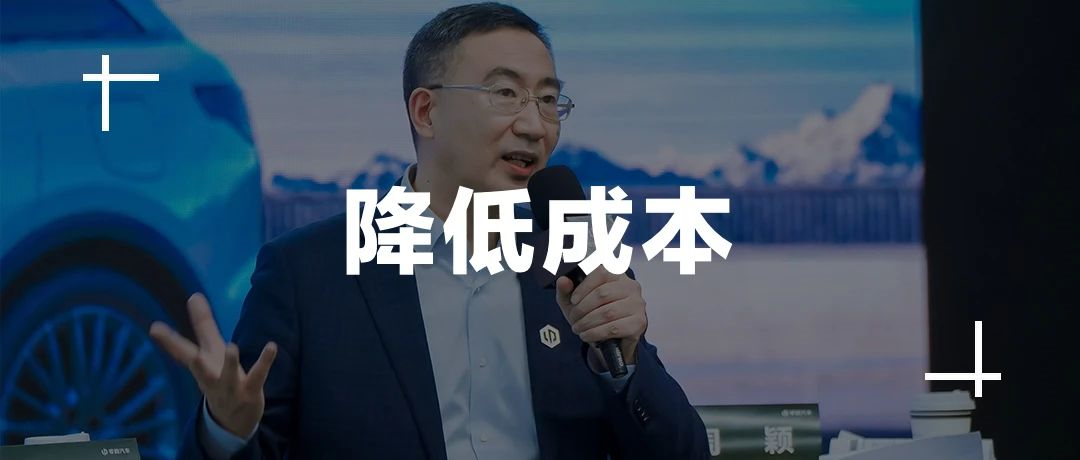ZeroRun’s Founder, Zhu Jiangming Shows Confidence in the Company’s Cost Leadership Position
Author: Mu Mu
“Many people believe that ZERO RUN vehicles are cost-effective, but it is more like a tactical move. From the beginning, we were clear on what ZERO RUN wanted to achieve, and why there has been a surge in new car companies in recent times. Essentially, it is due to the fact that these companies have been able to weed out overpriced and poor-quality products.
We hope to provide better products and services for our customers, and as for how much we want to charge for our products, I believe that it is important for ZERO RUN to make our customers feel that they are getting a good deal. This is why we have chosen to independently develop many of our core components from the start.
To give you an idea, the cost of independently developing ZERO RUN’s entire vehicle has already exceeded 70%, which is the reason behind our current pricing.”
This was part of what Zhu Jiangming, ZeroRun’s chairman, expressed during a discussion meeting at the end of 2022.
Overall, I agree with what he has said. Looking at the history of car development, self-development has many advantages for automakers, with cost being just one of them.
Since last year, ZeroRun has undergone some changes, and we hope to have a rational discussion about this company.
ZeroRun’s “Late Spring Chill”
ZeroRun actually had a decent 2022.
In terms of car deliveries, ZeroRun delivered 21,579, 30,415, 35,608, and 23,566 cars respectively each quarter, with a total of 111,168 delivered, which is quite average in the domestic new energy vehicle market.
On September 29, 2022, ZeroRun successfully debuted on the Hong Kong Stock Exchange with a market capitalization of HKD 32 billion, becoming the fourth new automaker to go public following WeRide. During a time of stagnation in the new energy vehicle capital market, ZeroRun’s performance was relatively strong. However, ZeroRun’s steering committee chairman, Zhu Jiangming, is not satisfied with the company’s current stock price, as he believes that it has not yet reflected the true value of the enterprise.
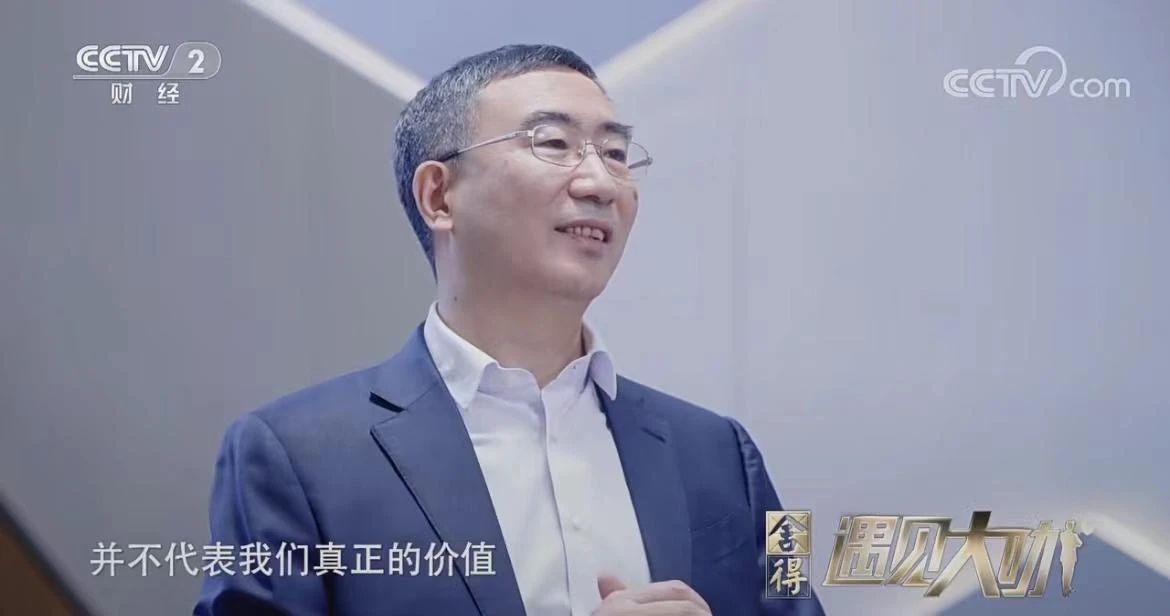
But as of 2023, with the relaxation of the pandemic, the return of normal economic life and the cancellation of the national subsidy for new energy vehicles, the Chinese new energy vehicle market is undergoing drastic changes.
Tesla was the first to raise prices, and with the first quarter being a low season in auto sales, consumer demand for cars was not that strong. This forced both gasoline and new energy vehicle companies to implement preferential and price reduction measures, and ZeroRun has followed suit, offering a series of discount packages.During the first two months of the new year, Leapmotor Motors delivered 1139 vehicles in January and 3198 vehicles in February. This result is less impressive compared to previous months, but it is not just a problem for Leapmotor, rather the entire Chinese automotive market is facing difficulties.
Therefore, Leapmotor has accelerated its pace of change and strategy, including the launch of an extended-range electric vehicle model that is currently popular with consumers – the Leapmotor C11 extended-range model – in the hope of gaining more market share.
On the other hand, Leapmotor has accelerated the pace of new product launches. On March 1st, Leapmotor launched four new vehicles, including an extended-range C11 model with a price cut to below 150,000 RMB, and the prices of other models were also reduced to varying degrees, officially joining the price war.
Many outside comments believe that Leapmotor’s price reduction “may not completely solve the problem, but it can solve the competitors” because consumers are not foolish and will have their own price expectations for certain types of vehicles after various comparisons. Therefore, Leapmotor’s price reduction directly puts pressure on its competitors such as BYD Song and Shenzhen Blue SL03 (C01 competitor) and S7 (C11 competitor).
The group of data on Leapmotor’s insured vehicles during the two weeks after the release of the four new cars is as follows: around 100 C01 vehicles, around 400 C11 EVs, around 240 extended-range C11s, and around 300 T03s, totaling around 1000 vehicles. The effect of the price reduction has not yet been realized, and of course the C11 extended-range version has just been delivered and the new model has just been launched, so let’s wait and see.
Leapmotor has always advocated “15,000 RMB for experience worth 300,000 RMB”, which is essentially superior benchmarking.
At this product launch event, Leapmotor has always emphasized the “value for money” of its products from multiple dimensions such as vehicle appearance, range, space performance, comfort features, intelligent experience, and driving experience.As a new brand, ZERØ RUN has shaped its image as a low-key and pragmatic “tech nerd” brand without much celebrity aura or public attention. They aspire to be users’ contract factory, aiming to offer better value-for-money and eliminate the hyped brand premium.
In fact, this strategy is no problem and even a good thing for consumers.
If you have chosen the hardest road, you must stick to it.
How to do it?
- Consumers must perceive ZERØ RUN’s value-for-money.
- Consumers must be convinced that ZERØ RUN’s “self-developed technology” brings better technology and experience.
- Consumers must know about the ZERØ RUN brand and be willing to visit the store and see its products.
In the end, they need to work on the brand and channels, let consumers see and appreciate the brand, and see and experience the actual car when they want to. After all, “good wine needs no bush.”
Moreover, ZERØ RUN lacks a strong brand personality. Consumers do not want a “water tank car” but a car that meets their needs and has their own brand style and personality. The success of the T03 actually stems from the fact that it is a car that can meet the needs of specific consumer groups.
All of this requires ZERØ RUN to think and adjust carefully.
Of course, we cannot expect ZERØ RUN to spend money like luxury brands to build their brand, as their financial strength does not allow this. Their current cash reserve of over RMB 10 billion is incomparable to the RMB 50 billion of other new car brands.
Selling cars is a consumer-facing business. Spending more money to enhance brand strength will definitely yield better results. ZERØ RUN’s “self-developed technology” is several levels stronger than the “wholly undeveloped technology” of some other car companies.
Next, this article will briefly review ZERØ RUN’s development and what we can expect in the future.
ZERØ RUN’s self-developed technology
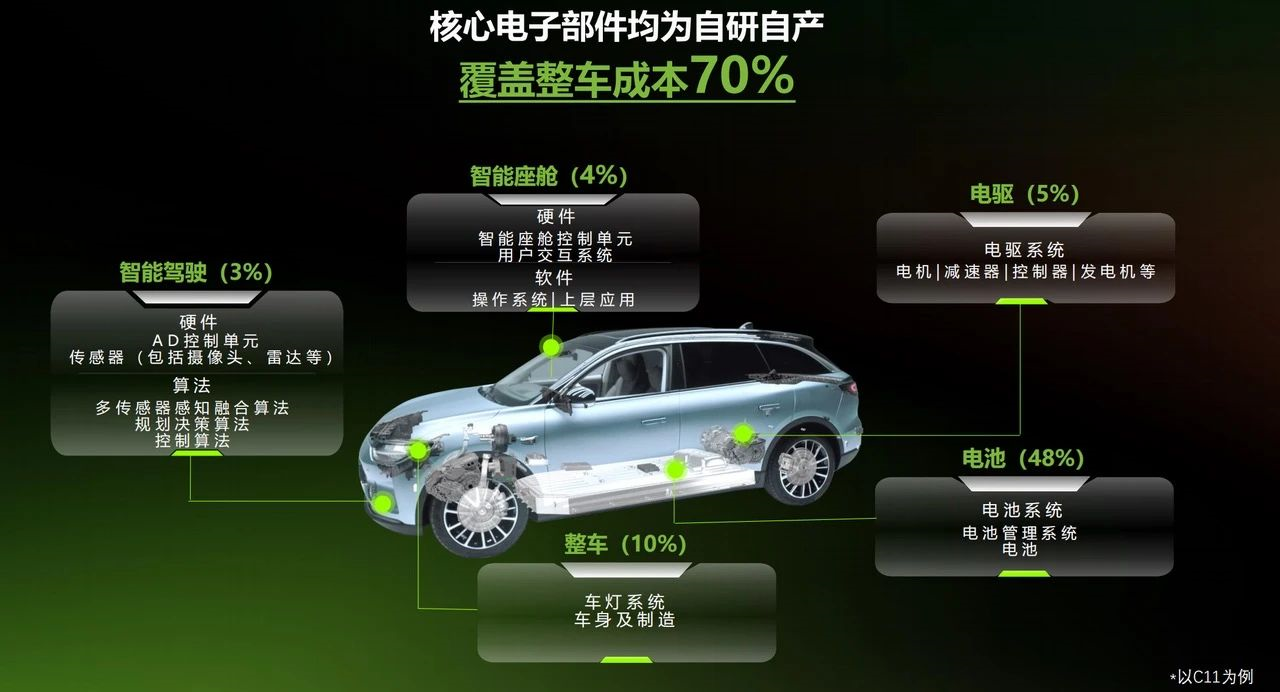
First of all, we must talk about ZERØ RUN’s technology, which is the “self-developed technology” that ZERØ RUN has always emphasized.
Many domestic new car brands are making self-developed efforts, with self-developed components ranging from software to hardware. Software includes intelligent cockpit systems, intelligent driving systems, operating systems, etc., while hardware includes various domain controllers, autonomous driving chips, batteries, seats, etc.# Leapmotor: All-Around Self-Research in Automotive Industry
Among all automakers in China, Leapmotor is one of the few who really achieve “all-around self-research”.
“All-around self-research” refers to the independent research and development of the most important aspects of the automobile, such as power, intelligent driving, and cockpit systems, from the bottom layer, achieving the self-developing of both software and hardware.
Naturally, there are many advantages to doing such “all-around self-research”, such as controllable R&D costs, stronger overall vehicle performance, and stronger supply chain risk resistance, and so on.
According to Leapmotor’s official statement, leveraging the self-research of software and hardware has maximized the efficiency of the company in the R&D and manufacturing phases, and thereby maximized the lifetime value of owning a car for users.
Self-research has its advantages, but it also means greater time costs, capital costs, and the risk of developing products that are not easily marketable than turning to mature suppliers in the market.
In fact, despite the time costs, Leapmotor has already launched four saleable models, including cars and SUVs, during its all-around self-research process, along with launching extended-range models as well. It appears that all-around self-research has not significantly affected its production and delivery schedule.
As for the capital investment, Leapmotor invested RMB 242.5 million, RMB 283.9 million, and RMB 404 million in the first three quarters of 2022, totaling RMB 93.04 billion. From 2019 to Q3 2022, Leapmotor has cumulatively invested RMB 2.3179 billion in R&D.
For example, Leapmotor’s “all-around self-research” relies on the internal cultivation of talents. The following chart shows the designated personnel in different technological modules in Leapmotor, and all of them have grown up within the company. For a car company with a relatively short history, these people are valuable resources.
Of course, many companies can obtain top talents at high salaries from external sources, but these talents may not necessarily be suitable for the company itself. Therefore, Leapmotor chooses to grow and promote talents internally, which is perhaps the most suitable path for its business characteristics.
In this context, how has Leapmotor’s “all-around self-research” contributed to the automobile industry?
Leapmotor claims that it has independently researched, designed, and manufactured all core systems and electronic components for intelligent electric vehicles, and has developed the intelligent power system (Leapmotor Power), intelligent driving system (Leapmotor Pilot), and intelligent cockpit system (Leapmotor OS).### Zero Run’s “All-domain self-research” in detail
As an automotive translator, my responsibility is to translate, proofread, and revise the English text to make it more elegant and refined while ensuring the essence of the original text, focusing on correcting and improving without any explanation.
Vehicle Architecture: 800V Architecture on Board
The vehicle architecture is the core technical foundation of car production, directly affecting product performance and user experience, and encompasses various modules ranging from the body, chassis, battery, electric drive, to electronic architecture.
In terms of the vehicle architecture, Zero Run adheres to the concept of “one architecture, three platforms.”
What does that mean? It means that under one vehicle architecture, there are three vehicle platforms, A/B/C, that can cover the A0-C level vehicle products (S01 and T03 were included in these three platforms as well), with a core length of 3600-5200mm and a wheelbase covering 2400-3100mm. Each platform also has the development flexibility to expand into SUVs, sedans, MPVs, and other vehicle types. The CTC power battery architecture can achieve various energy storage configurations through internal arrangement differences, and the power platform includes various combinations such as range extenders and pure electric models, with a platform commonality rate of 88%.
For example, Zero Run’s mainstream models currently are C11 and C01, both C-platform vehicles. There will be B and A-platforms available in the future, such as the anticipated B11 mid-sized SUV in the second half of 2023 and the A11 compact SUV in 2024.
In terms of the vehicle architecture, there are many noteworthy points in Zero Run’s future plans:
Firstly, in terms of design, future models will undoubtedly have more youthful design language, featuring Zero Run’s second-generation design concept.
Another important plan is that the future vehicle architecture will support an 800V or higher voltage platform, a powerful tool to greatly alleviate range anxiety for pure electric vehicles, as Zero Run does not do battery-swapping.
In addition, line-controlled chassis technology supporting L4 autonomous driving and a centrally integrated electronic architecture are also included in Zero Run’s future vehicle architecture plans.Currently, it is clear that over the next three years, Leapmotor will launch seven new models.
Electrical/Electronic architecture: the goal is central integration architecture
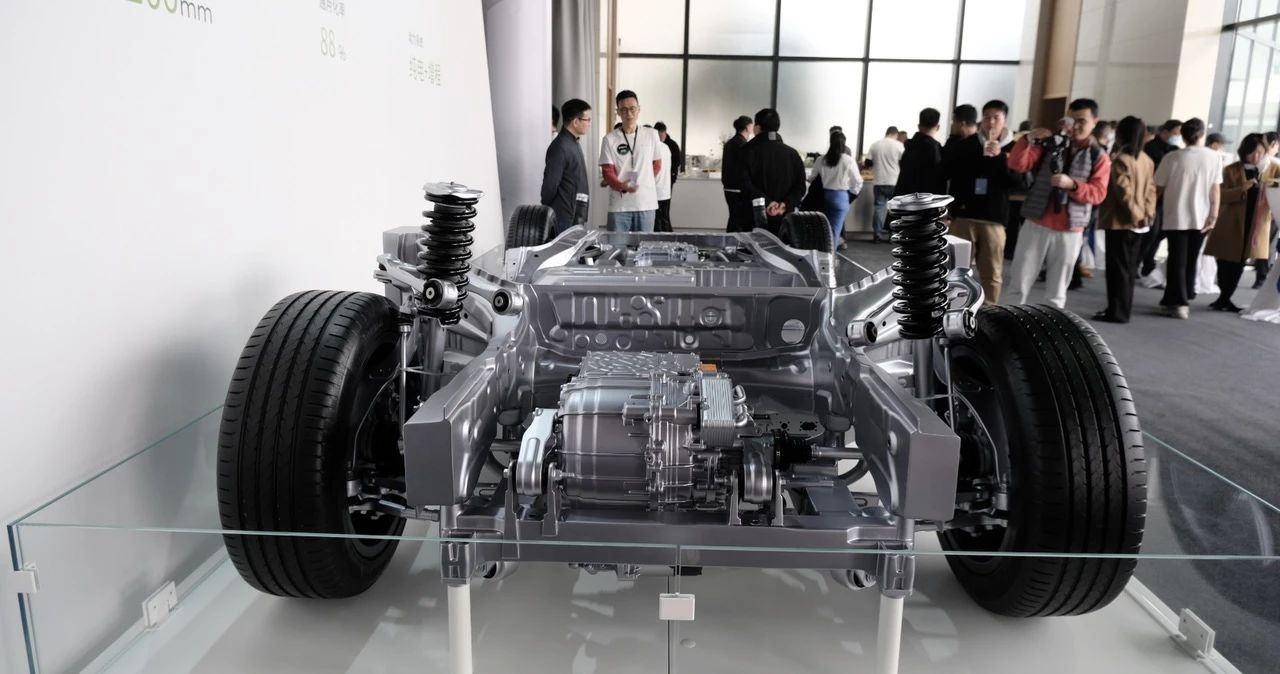
Everyone is talking about software-defined cars and central integration control.
Currently, Leapmotor has successfully mass-produced distributed electrical/electronic architecture and domain control electrical/electronic architecture. In 2023, it plans to launch a central integration electrical/electronic architecture.
Leapmotor’s entire vehicle control product line has completed the mass production of several products, including vehicle control units, body control units, and seat control units. Furthermore, Leapmotor C11 and Leapmotor C01 are equipped with domain control units for both driving and parking and an intelligent cockpit domain control unit.
In the future, Leapmotor will integrate the software and hardware of entire vehicle systems to develop a central integration electrical/electronic architecture, which will reduce the weight of the entire vehicle harness, realize the sharing of vehicle perception, computing capability, and power supply, and build the framework for software-defined cars.
Simultaneously, Leapmotor will develop an entire vehicle control system with intelligent energy management to address drivers’ range anxiety and improve the driving range and comfort.
Battery architecture: Second-generation CTC technology and ultra-fast charging are on the way

Leapmotor does not develop battery cells; however, it can integrate battery cells, whether in the form of battery packs or battery chassis integration technology, both of which Leapmotor is currently developing simultaneously.
Leapmotor’s data shows that it has built two battery bases and is building one battery base. Moreover, currently, it has nine complete battery production lines and an annual production capacity of 380,000 units, with a planned total capacity of 780,000 units per year.
The most critical aspect of Leapmotor’s self-developed battery architecture is the CTC battery chassis integration technology. Leapmotor vehicles featuring this technology have advantages in terms of performance, range, safety, and space.
Moreover, CTC technology is highly compatible with the entire vehicle, allowing for flexible and rapid mass production. Leapmotor is also refining it further for increased integration and modularity, enabling platform adaptation to future classes and models – this is indeed future-proofing.And with the launch of the 800V high-voltage platform, CTC technology will also be compatible, and the two will work together, allowing a 5 minute charge to deliver a range of 200 kilometers.
The first generation of CTC technology debuted on the C01, and future models will also feature it. Moreover, the second generation of CTC technology is currently under development and will be released by 2023, with significantly improved performance.
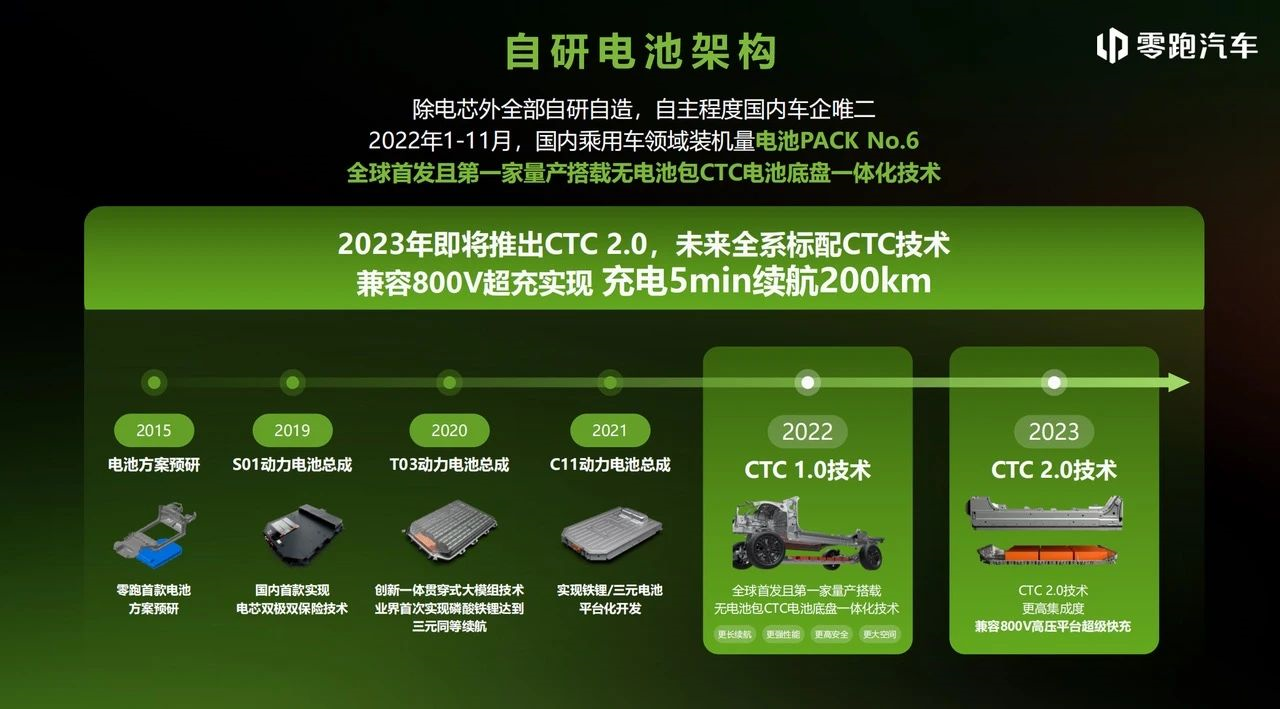
In order to match the 800V high-voltage platform, LI Automotive is also preparing for super-fast charging technology, so that it can truly be used by consumers after the production of future models, and to avoid the embarrassment of having no charging infrastructure.
In terms of batteries, one crucial and often overlooked point is the recycling and residual value assessment of batteries, and LI has plans for this as well.
Its plan is to develop a cloud platform for big data residual value assessment, to improve battery recycling and utilization in 2024, and to establish a sound residual value assessment mechanism in 2025, addressing consumers’ concerns about the depreciation of electric vehicles and providing a reference for the industry evaluation system.
It is clear to see that LI has given careful consideration to the battery architecture layout.
Electric Drive Architecture: Pursuing Higher Performance
In the field of electric drive systems, LI Automotive is the only team in China that has the research and production capabilities for multi-in-one, three-in-one, water-cooled/oil-cooled and range extension systems, fully mastering the electric drive architecture and core module design, and possessing full-dimensional virtual simulation and forward-looking design capabilities for electric drive products.
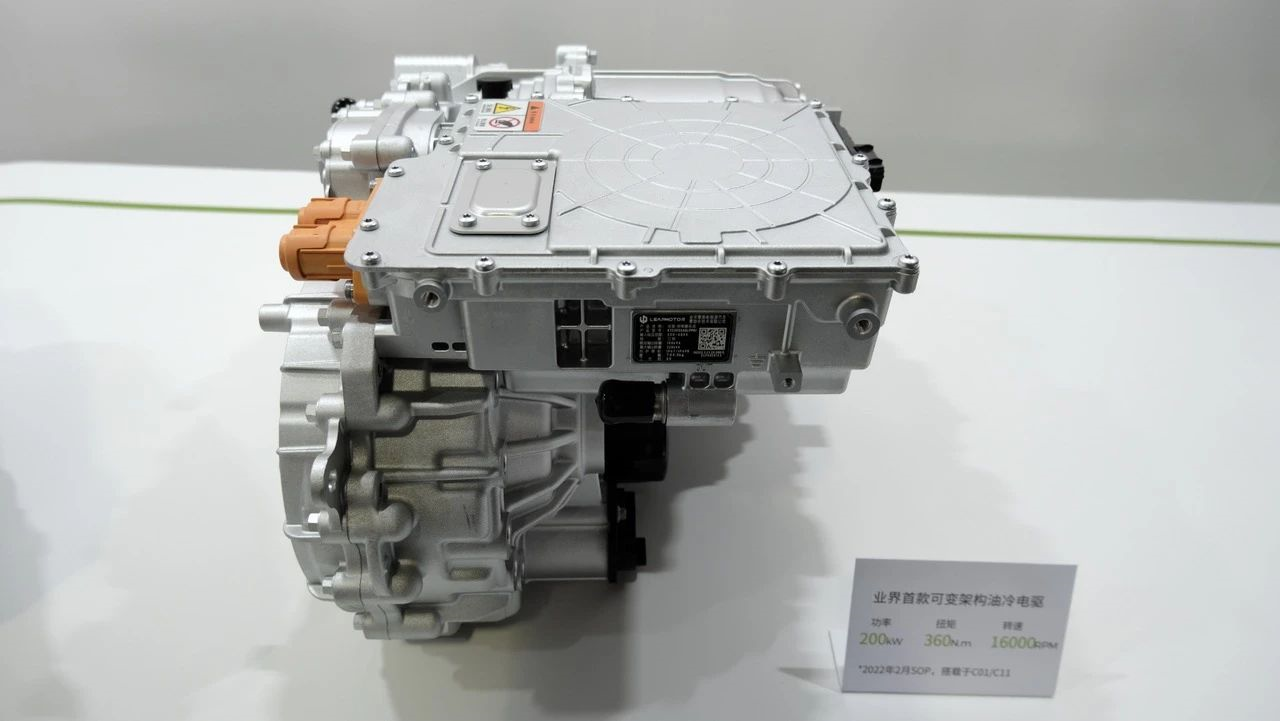
In terms of products, they include the first-generation water-cooled electric drive product, the second-generation oil-cooled electric drive product, and the third-generation oil-cooled electric drive product.
The characteristics of the third-generation oil-cooled electric drive product are: lightweight, multi-in-one, and mid-to-high voltage silicon carbide materials, with unique advantages in performance, efficiency, quality, and size, significantly enhancing the driving experience of the vehicle.
Next, LI Automotive will also independently develop higher-performance, higher-speed ultra-large power electric drives, with a speed of up to 25,000rpm, enhancing the vehicle’s acceleration performance, after all, with Tesla’s Model S Plaid as a benchmark.### Smart Driving: LiDAR + Orin Chipset is Worth Expecting
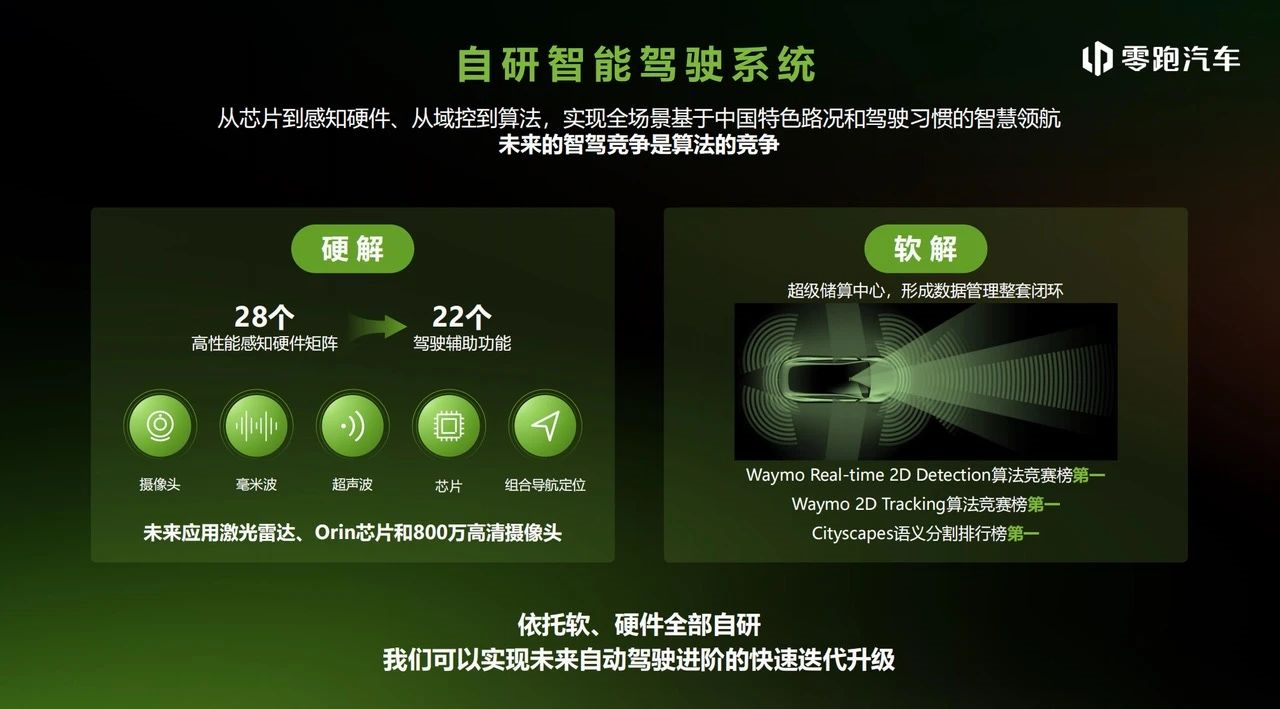
In terms of smart driving technology, LI has achieved self-research and development in ADAS domain controllers, system architecture, perception, multi-sensor fusion, positioning, prediction, regulation, AI training platforms, etc.
In terms of hardware, LI has achieved self-research and development of all intelligent driving hardware and software. With 28 components and 11V5R already installed, LI has independent supply capabilities ranging from intelligent driving chips to domain controllers, from camera visual perception components to radar wireless perception components.
In terms of software, LI has the independent research and development ability of full-domain intelligent driving technology evolution, from map positioning to perception algorithms, from underlying systems to control strategies. Users can quickly iterate experiences through OTA.
Of course, this is not enough. LI is developing a high-level intelligent driving solution for all scenarios, including the use of LiDAR sensors and NVIDIA Orin chipsets.
Moreover, LI also follows the road of valuing visual perception and light high-precision maps to reduce the impact of map updates on user intelligent driving experiences.
Although LI currently has the ability for self-research and development in intelligent driving software, the performance of intelligent driving systems in mass-produced vehicles is not yet excellent. Perhaps we can look forward to the intelligent driving functions that LI will create based on the “LiDAR + Orin” solution in the future.
Smart Cockpit: New Cockpit Chipset

In fact, the three-screen experience of LI automobiles is remarkable in models of this price range, and the intelligence experience is better than that of most oil-fueled vehicles. This is beyond doubt.
Its intelligent cockpit is currently self-researched and has gone through two generations and is moving towards the third generation.
- The first generation was based on the TI J6 platform + Qualcomm 8-core car chipset platform, supporting facial recognition and allowing control of the vehicle via Apple’s Siri on the phone.
- The second generation is based on the Qualcomm 8155 chipset and has realized the three-screen intelligent cockpit system, with three-screen interaction, facial recognition, AR landscape navigation, continuous voice interaction, visible and speakable functions, etc.- The third generation will be a real-time multi-core heterogeneous system that integrates whole-vehicle entertainment, interaction, vehicle control, and autonomous driving fusion perception, connectivity, and computing power. It will adopt the next-generation intelligent cockpit main control chip and based on the central domain control architecture, integrating intelligent cockpit and intelligent driving to realize “software-defined cars.”
In addition to self-developed core technology, LI has a gene of “self-manufacturing.”
LI Automobile’s Jinhua production base, built in accordance with the Industry 4.0 standards, has stamping, welding, painting, final assembly, and three electric production lines. It has realized highly intelligent manufacturing through new technologies such as large-scale robots, machine vision, intelligent transportation, and industrial Internet.
From self-development to self-manufacturing, what LI has done is not like a new car company established for only 7 years. Its annual R&D investment is not a mode of waste and extravagance, but rather spending money on the cutting edge.
Of course, so many technical reserves ultimately need to be translated into products to exert their value, and products also require sales volume to dilute the R&D costs. Otherwise, it would be like smashing technology in one’s hands and unable to fully realize its true value.
Test of Product Positioning and Sales Volume
Focusing on the product itself, LI Auto’s existing and planned product lines mainly include:
- S Series: S01 (out of production)
- T Series: T03 (pure electric vehicle)
- C Series: C11 pure electric, C01, C11 extended range, C01 extended range, and subsequent models
- B Series: The first car model is a mid-to-large-sized SUV (including pure electric and extended range)
- A Series: Focusing on pure electric, compact-sized SUV
There will be 7 new cars in the next 3 years.
One interesting point is: will there be new products in the T Series? How high can the price of the B Series be raised?
In fact, LI initially followed the pure electric route, but the market demand caused its strategy to change. Currently, LI is taking the “pure electric + extended range” parallel route. After all, at this time, they produce whatever car models sell well.
However, blindly following is not a long-term solution. The company still needs forward-looking vision, so the 800V + super fast charging is also in LI’s plan.
It can be confirmed that LI should not make battery-swapping or hydrogen-powered car models.
Is it a good choice for LI to do extended-range? Is it too late? It’s actually not bad. After all, in the Chinese new energy vehicle market, the sales volume of pure electric vehicles last year was 5.365 million units, a year-on-year increase of 81.6%. The sales volume of plug-in hybrid electric vehicles reached 1.518 million units, a year-on-year increase of 1.5 times, with a higher growth rate than pure electric vehicles.This also means that there is still great potential in this market, and it is the ardent supporter of extended-range vehicles. Moreover, the overall sales performance is impressive.
Since it is a model developed based on demand, whether LINGPAI’s extended-range models can sell well depends on whether their real driving quality and user experience can win over consumers.
Currently, LINGPAI’s main selling model is the T03 small car priced under 100,000 yuan.
The price range for sedans and SUVs is between 150,000 and 230,000 yuan (if various discounts and preferential policies are taken into account, it can be reduced to around 150,000 to 200,000 yuan), making it really tough competition. It’s a competition for comprehensive strength, not just technology and price. Instead, it’s a competition for brand, reputation, user experience, after-sales service, and other comprehensive strengths. And customers within this price range are the most demanding.
If the brand wants to aim higher and raise prices, it must have corresponding products and a brand image to go with it. Therefore, it remains to be seen whether LINGPAI can invest in its brand to achieve just that, with the upcoming combination of “medium and large SUV models, 800V ultra-fast charging, laser radar, and Orin chips”.
Although small cars like T03 sell well, the profit margin is too low and cannot support LINGPAI’s “completely self-developed” strategy.
Throughout 2022, of LINGPAI’s delivery volume of 111,168 units, T03 accounted for more than 60,000 units and C11 and C01 together contributed 50,000 units. This sales structure does not look very healthy and must be improved.
As far as international expansion is concerned, LINGPAI follows a strategy. The first stop has been Israel, where three stores have been opened, and the company plans to go to Europe and establish local flagship stores. This is obviously a more difficult task, but it cannot be avoided.
As a matter of fact, LINGPAI’s plans for this year are fairly obvious, including four recently launched updated models and the C01 extended-range model and new B-platform vehicles planned for this year. Whether extended-range models can sell well is particularly critical. In addition to this, it remains to be seen whether LINGPAI has any hidden surprises.
Zhu Jiangming is actually quite anxious and has said before, “If LINGPAI’s sales volume does not increase in 2023, the competition pressure will be even greater.”
On the road to cost-effectiveness, Tesla’s next-generation models and Xiaomi’s cars will be launching next year, making the competition even fiercer.
这是一个 Markdown 文本示例
下面是一个无序列表:
- 第一项
- 第二项
- 第三项
下面是一个有序列表:
- 第一项
- 第二项
- 第三项
这是一个超链接:Markdown 教程
这是一个代码块:
<div>
<h1>Hello, world!</h1>
</div>
这是一张图片:

以上是示例。
This article is a translation by ChatGPT of a Chinese report from 42HOW. If you have any questions about it, please email bd@42how.com.
